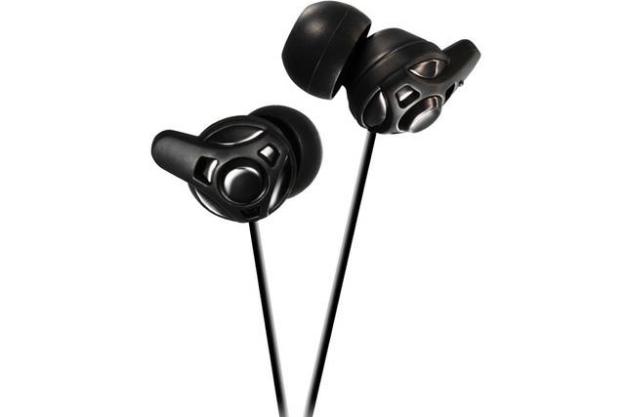
“The fit, comfort and security are excellent, especially for only $30 — and they still sound noticeably better than the dreadfully awful giveaway buds often included with your MP3 player or phone.”
- Noticeably better sound than stock mobile-device earbuds
- Plenty loud with any device due to high sensitivity
- Good amount of bass
- Angled ear tubes and rubber-fit stabilizers provide comfortable, secure fit
- Somewhat bright, harsh-sounding upper mids and treble
- Lower-than-average noise isolation
- Awful, scissors-only blister packaging
Look around at some of the latest electronic gadgets out there and chances are good you’ll find a healthy chunk of them will have one buzzword in common: carbon. A quick search on Amazon turned up well over 100,000 items that mentioned carbon fiber in their descriptions, ranging from things like wristwatches and iPhone cases to men’s bracelets and… wedding ring bands?
It appears this trend hasn’t gone unnoticed by JVC either, which bills its HA-FX40 earphones as “The world’s first headphones to use new carbon nanotubes technology.” All marketing lingo and buzzwords aside, we were more interested to hear how these low-cost $30 earphones sounded compared to the throwaway ‘buds that come with iPods and their ilk. Read on for our findings.
Out of box
Having evaluated plenty of earphones lately, we’ve seen them come in all different kinds of packaging, some worse than others. Unfortunately, the JVC HA-FX40s came in the worst packaging of all: a small, hermetically-sealed, impossible-to-open-with-your-bare-hands blister pack.

Once we did manage to open up the HA-FX40’s packaging, we found a total of four sets of eartips, including one pair of memory foam tips, a cord clip, and instructions printed on the internal card stock… which we nearly destroyed in the process of cutting apart the blister pack.
Features and design
True to their marketing, the HA-FX40s feature diaphragms made out of carbon nanotubes. It’s unclear whether or not the diaphragms are made exclusively from this material, as JVC’s website description doesn’t provide any further details, but the result is reportedly clearer and crisper sound. Other features include: dual-layer, aluminum-plated housings that are said to provide excellent noise isolation; angled eartips to better seat the eartubes within the ear canal; and rubber fitting stabilizers for better security.

Performance
We used these JVCs the way we figured most folks purchasing a $30 set of earphones would — straight from the headphone outputs of an iPhone 4, iPod shuffle, and Dell laptop. We also kept handy some stock iPod shuffle earbuds and a plethora of giveaway earbuds for comparison.
We then started listening to the HA-FX40s the way we figured most buyers would as well —straight out of the package with no break-in. We were immediately impressed with their prodigious output capabilities: The JVC HA-FX40s played noticeably louder than almost every other set of earphones we had on hand. Those craving an unhealthy amount of volume should have no trouble getting it from the JVC HA-FX40.
Starting from the bottom sonically, the JVCs had a nice, weighty bass overall, even if it wasn’t terribly deep. At times, they could sound just a little too ripe on bass-heavy music, such as on the tracks “Paper Tiger” and “Guess I’m Doing Fine,” from Beck’s seminal album Sea Change. Taken as a whole, though, we definitely preferred the HA-FX40’s more ample bass to the lean presentation from many of the giveaway earphones we had on hand.
The JVCs also had pretty decent lower midrange detail for such a low-priced set of earphones. While they had a tough time with things like developing a piano’s complex harmonics and transients, the HA-FX40s never seriously clipped instrumental timbres either. Again, the JVC earphones definitely provided more enjoyable sound than anything we’ve ever heard from stock iPod buds. We think this is fairly impressive, given their $30 price tag.
While the HA-FX40s do have a clear and crisp sound as promised, they also have one glaring sonic bunion as a result: An upper midrange and treble that’s just too bright and etched sounding. Even after 20 hours of break-in, both male sibilants and female vocals sounded consistently emphasized, giving anything with higher frequency information an unnatural and distracting harshness and overall edginess. Cymbals were just too sizzly; horns too brassy; and piano too tinkly. Still, this wasn’t a huge deal given the HA-FX40’s price, and overall they offered far better sound than the low-cost competition.

Even though JVC mentions that the HA-FX40s should provide excellent noise isolation, we actually found them to be somewhat below average in this regard. The JVCs did eliminate a little bit of noise, but we could still clearly hear conversations and TV sound. Buyers looking for more robust noise isolation should probably look elsewhere.
Conclusion
Despite their somewhat bright and harsh treble, the JVC HA-FX40s do have a lot going for them. The fit, comfort and security are excellent, especially for only $30 — and they still sound noticeably better than the dreadfully awful giveaway buds often included with your MP3 player or phone. If you’re looking for a step up from your stock earbuds without breaking the bank, and don’t mind a lot of extra sizzle in your sound, give the JVC HA-FX40s listen.
Highs
- Noticeably better sound than stock mobile-device earbuds
- Plenty loud with any device due to high sensitivity
- Good amount of bass
- Angled ear tubes and rubber-fit stabilizers provide comfortable, secure fit
Lows
- Somewhat bright, harsh-sounding upper mids and treble
- Lower-than-average noise isolation
- Awful, scissors-only blister packaging


